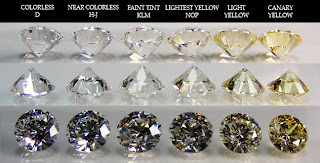Planning a wedding all begins with getting engaged and we
all know that your engagement isn't official until you have the rock to prove
it! Whether you trust your fiancé to choose the ring (YIKES!!) and surprise you
or you’re picking the ring out together; it will be important for the both of
you to know the “4 C’s” of shopping for the perfect diamond or gem of your
liking. Keep in mind that it’s important for you, as the bride, to have a
diamond that you feel comfortable wearing and meshes well with your
personality.
1. Cut
– the shape of the diamond. Diamonds and gems come in many different shapes and
can sometimes create the illusion that it is bigger. For example many women
choose the oval diamond because it gives off the illusion of being bigger, in
comparison to the round diamond.
2. Clarity
– is the degree to which the diamond is free of flaws. This determines the “sparkle
effect” that your diamond reflects from light. You will be able to know if you’re
diamond has good clarity if it does not have an appearance of being whitish or
cloudy and has limited surface scratches.
Be
sure to ask when shopping for diamonds what the “grade” of the diamond/gem is. There
are six possible grades that a gem can be classified as, which are: (lowest
grade to highest grade) I2-3, I1, SI1-2, VS1-2, VVS1-2, and Flawless. Obviously,
the higher the grade the more expensive your diamond/gem will be, because of
how rare it is to find flawless diamonds.
3. Carat
– is the size or more precisely the weight of the diamond. Many of us refer to
the carat size as how big the diamond actually is which can clearly classify its
price. If you want to have the appearance of one big diamond, but can’t afford
the cost of one then I recommend looking at a setting that places 4 smaller
diamonds into quadrants. The quadrant effect gives off the illusion of one big
diamond.
4. Color
– A diamonds can be found in most colors, but more commonly you’ll see them
ranging from a white (colorless) to a faint yellow (lightest yellow). The more
white (colorless) the diamond than the more expensive the diamond will be.
Also, depending on the hue and intensity of a diamond’s color can either lessen
or increase the diamond’s value. Besides those diamonds with a yellow or brown
tint (these colors are very common and easy to discover), colored diamonds are
very valuable and expensive. For example, blue diamonds, such as the hope
diamond, are extremely valuable because of how rare they are.
Hope Diamond
5. Certificate - this is just an additional “C” I am adding to the “4 C’s”. Gaining a
certificate from a gemological laboratory for your ring, ensures your diamond’s
grade and cut.
ENGAGEMENT RINGS - PERSONAL FAVORITES
ENGAGEMENT RINGS - PERSONAL FAVORITES






































.jpg)
.jpg)
.jpg)
.jpg)
.jpg)

No comments:
Post a Comment